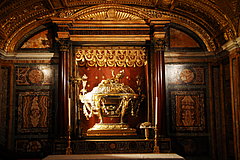
Origin
This church is one of the four papal basilicas in Rome. It was built under Pope Sixtus III (432-440) on the site of an older basilica.
The basilica was to commemorate the Council of Ephesus, which not only asserted the divinity of Christ, but also proclaimed the divine maternity of Mary, Mother of God.
Important facts
A Latin inscription dating from the 5th century invokes the Virgin Mary and recalls that the martyrs were witnesses "of her womb," i.e the fact that Mary is the virgin mother of the Son of God.
The basilica is also called “Mary at the Manger,” because of a few small wooden boards believed to be a relic of the manger of Bethlehem.
The basilica is also known as “Our Lady of the Snows,” on account of the miraculous snowfall that indicated the location for the first basilica.
The icon "Salus populi Romani" (6th or 8th century) is housed at St Mary Major in the Paoline Chapel (or Borghese Chapel) to the left of the central nave.
The apse, with the magnificent mosaics by Torriti, was added in the 13th century.
The two side chapels were built in the second part of the 17th century: the Sistine Chapel is on the right side and the Paoline Chapel on the left. The latter is particularly refined and contains the icon "Salus Populi Romani," probably dating from the 8th century and one of the most venerated in Rome.
Feast day: August 5th
The feast day commemorates the dedication of the church and the miracle of the snow that indicated its future location. The tradition is to drop white flower petals inside the basilica on that day.
Because of the ties with the council of Ephesus, the dedication of the basilica is included in the universal Roman calendar and celebrated on August 5th, holding the rank of “memorial.”